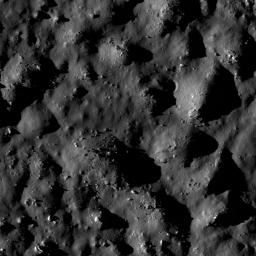
|
The Floor of Tycho
- Click the image above for a larger view
- Full-Res JPEG (1000 x 1000) (139.5 kB)
- Full-Res TIFF (1000 x 1000) (1.0 MB)
Caption:
Boulders and impact melt line the floor of the 85-km crater Tycho, a potential site for future human exploration. Tycho crater is one of the fifty regions of interest in NASA's Constellation Program . Scene width is 620 m.
Tycho crater is an one of the most prominent craters on the Moon -- it appears as a bright spot in the southern highlands with rays of bright material that stretch across much of the nearside. Its prominence is not due to its size: at 85 km in diameter, it's a just one among thousands of this size or larger. What really makes Tycho stand out is its relative youth. It formed recently enough that its beautiful rays, material ejected during the impact event, are still visible as bright streaks. All craters start out looking like this after they form, but their rays gradually fade away as they sit on the surface, exposed to the space environment which over time darkens until they fade into the background.
Background Info:
NASA's Goddard Space Flight Center built and manages the mission for the Exploration Systems Mission Directorate at NASA Headquarters in Washington. The Lunar Reconnaissance Orbiter Camera was designed to acquire data for landing site certification and to conduct polar illumination studies and global mapping. Operated by Arizona State University, the LROC facility is part of the School of Earth and Space Exploration (SESE). LROC consists of a pair of narrow-angle cameras (NAC) and a single wide-angle camera (WAC). The mission is expected to return over 70 terabytes of image data.
Cataloging Keywords:
| Name | Value | Additional Values |
|---|---|---|
| Target | Moon | |
| System | Earth | |
| Target Type | Satellite | |
| Mission | Lunar Reconnaissance Orbiter (LRO) | |
| Instrument Host | Lunar Reconnaissance Orbiter | |
| Host Type | Orbiter | |
| Instrument | Lunar Reconnaissance Orbiter Camera (NAC) | |
| Detector | Narrow Angle Camera (NAC), Wide Angle Camera (WAC) | |
| Extra Keywords | Crater, Grayscale, Impact | |
| Acquisition Date | ||
| Release Date | 2010-01-14 | |
| Date in Caption | ||
| Image Credit | NASA/GSFC/Arizona State University | |
| Source | photojournal.jpl.nasa.gov/catalog/PIA12941 | |
| Identifier | PIA12941 | |
